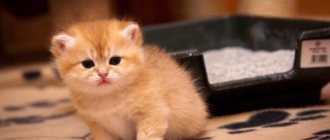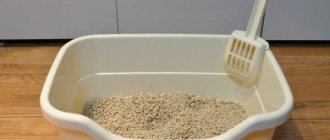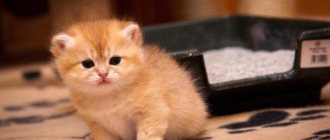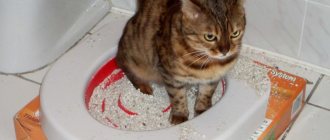There are a lot of people in the world who feel sorry for and warm animals, including homeless and defenseless ones. It happens that kittens are simply found, but they no longer have a mother cat. Then the care of the foundlings falls on the shoulders of those who want to help.
How to get a kitten to go to the toilet? In the first three weeks of life, kittens cannot take care of themselves. Then the act of defecation and urination is carried out only with active stimulation of the corresponding zones. Typically, the mother cat carefully licks the kittens under the tail, thereby causing emptying of the bladder and rectum. It is somewhat more difficult for a person to organize the process, especially if he has no experience in caring for kittens.
Recommendations
How to get a kitten to go to the toilet? After feeding, carefully and at the same time firmly fix the pet so that it cannot slip out. The fingers of the hand should be located simultaneously under the chest and stomach, so that the tail is towards the caregiver. You need to put a damp, warm napkin on your other hand, preferably white, but you can also use light colors, because it’s easier to tell on a light fabric whether the kitten went to the toilet or not.
Next, you need to stimulate the baby to urinate. Do not apply strong pressure and wipe the area from the lower abdomen to the anus. If the kitten went to the toilet (did not defecate - wiping continues), then you need to move to the anal area, doing a specific massage. Usually the effect occurs within a minute. But it happens that animals cannot go even after several feedings. Then you need to show him to a veterinarian.
After the job is done, you must first wipe the contaminated areas of the skin with a clean edge of the napkin (urine and feces are irritating, and dermatitis or a genitourinary tract infection may develop at the site of their appearance, since there is no strong immunity yet formed). It is also necessary to dry wet areas. This procedure is done for each kitten.
If there are several children, separate napkins are allocated for each of them (these can be pieces of bandage, gauze, cotton pads, which are thrown away after use). The whole procedure must take place in a warm room without drafts, otherwise the baby will become hypothermic and die.
Cases of constipation in kittens per month of life
The causes of constipation are varied, but most often occur due to improper feeding, since the stomach does not yet accept too solid food (it is accustomed to breast milk or formula), the presence of infestation or hair in the stomach (long-haired cats suffer more often).
It is easy to detect: the baby does not go to the toilet for more than two days, the tummy begins to increase in size, the animal is worried and meows pitifully, the kitten can squat into a defecation position, but nothing comes out (the discharge can be the size of a bean seed).
Squeezing feces
In most cases of spinal cord injury, cats retain the ability to defecate on their own. However, if the sacral region is damaged (for example, due to injuries that lead to the avulsion of the tail), fecal incontinence may occur. As with lower motor neuron type damage, the only way out for such animals is a diaper, since feces will constantly be released. However, in some cases, manual squeezing of the bladder can also stimulate the intestines, which will lead to bowel movements. It is not recommended to massage cats with constipation - first you need to find out the reason that led to constipation, this could be either unsuitable food or more serious pathologies.
Ways to help a kitten get things done
How to help a kitten go to the toilet? You can use enemas, the most effective are Microlax for children from zero years of age (after insertion, the anus must be closed with the tail, otherwise the microenemas will be of no use, and wait a little). In addition to the enema, massage the tummy in a clockwise circular motion. If feces appear from the anus, but cannot come out on their own, you need to begin to quietly and very carefully push it out. The kitten needs to be shown to a veterinarian not only if he was unable to go, but also for preventive purposes.
Massage technique
But in any case, the massage technique is the same and is divided into several stages.
Preparation
First of all, the owner and the cat must be calm; nervousness will ruin the mood and make the animal angry. A person needs to be confident in the benefits of the procedure and his manipulations.
You need to start the massage with one or two light strokes, and the procedures themselves from your favorite place.
Tactics for cat massage procedures
- The average duration of one session is 10-15 minutes, and approximately the same amount of time should be spent on each part of the body.
- All manipulations are carried out with the palm of one or two hands. Kneading with your fingertips will be weak and not even pleasant.
- On the head, special attention is paid to the crown, the area of skin around the ears and behind them, and the temples. It is better to massage it last.
- The neck should be massaged very carefully, without pressure or pressing. It is better to finger it easily.
- Then you need to confidently rub it a couple of times along the entire length of the cat’s body, without highlighting areas with pressure.
- The shoulders require careful work in a circular motion, possibly grasping the top of the paws.
- Afterwards, using the same movements, the back is smoothed to the hips.
- Most cats' thighs are very sensitive and require gentle massage.
- Abdominal massage is possible only if the animal is completely relaxed. Then he willingly allows himself to be turned over onto his back. Cats benefit from rubbing their pectoral muscles. Also, stroking the belly from head to tail will improve bowel function.
- The tail can and should be massaged from the hips to the tip and only if the cat does not twitch it.
© shutterstock
Outdoor toilet
How to train a kitten to go to the toilet in a private house? There are two methods to teach your baby to go to the toilet outside using a tray. The first is the gradual development of a habit. The second is the most common, but you need to monitor the animal’s reaction. If the baby looks for a dark corner after feeding, he tries to show that he wants to go to the toilet, in which case he needs to be taken outside. The actions must be repeated so that he can get used to doing his business near the house.
How to make a kitten go to the toilet if he is hiding? Close the doors before feeding, then he will be in sight. You can walk the cat after each feeding and wait for the result. This will have a good effect on digestion. Within a few days, you will develop the reflex to ask to go outside.
Care immediately after birth
Usually the cat independently arranges the space for childbirth and further feeding of the offspring. However, sometimes the animal chooses the wrong place from the owner’s point of view: for example, on the carpet behind the chair or next to the pillow on the bed. Then you need to independently prepare the so-called “nest” for the cat family.
A small box with low walls is best: place a blanket and disposable absorbent diapers in it, changing them as they get dirty. The box is placed in a warm, dark place so that the kittens are not disturbed by excessively bright light. The “nest” for newborns should not be in a draft, otherwise the pets may get sick.
If immediately after birth the kittens are left without a mother, a heating pad or container with warm water wrapped in cloth is placed in the box. This will help maintain body temperature and give babies a sense of security.
Toilet in the apartment
How to train a kitten to use the toilet in an apartment? Not all owners have the opportunity to take their pet outside after each feeding, especially since in the courtyard of a multi-story building there are many hidden dangers, ranging from physical injuries to infectious and invasive diseases. Therefore, it is advisable to accustom the kitten to the toilet in the apartment. To develop a strong habit, you need to take your baby to the place where the tray will be or is already located. When choosing a place for a cat's litter box, you need to take into account several nuances: cats do not like to be looked at during such a delicate task, the tray should be easy to get from this place.
Disease
In some cases, even very young kittens can be severely infected with helminths - the animal’s intestines are literally clogged with worms. Typically, such kittens have a large, swollen belly. Older kittens may swallow foreign objects during play (for example, threads or New Year's rain), which can also cause a lack of bowel movements due to intestinal obstruction. Usually this condition is accompanied by a general deterioration in health, refusal to feed, and vomiting.
Hurry up, choose a box and find out what gift awaits you
Discount on pet insurance
Promo code copied to clipboard
Kitten training
How to get a kitten to go to the toilet if the previous owners did not teach him to go to the litter box? The main thing is not to get upset. During the day, you should watch your pet and take it to the place where the tray should be located. If the pet made a puddle or something else: for example, a person went into another room for literally half a minute or absent-mindedly missed the moment - then it is imperative to immediately clean up after the baby and clean the area with a strong-smelling detergent (if this is not done, the wrong habit may form) . Cats use their scent to navigate where to go to the toilet, and the kitten will return to this place again and again, rather than go to the litter box.
Consequences of improper care for a paralyzed cat
Often the procedure of manual squeezing causes concern - the efforts that need to be made for this are quite large, and owners may feel that they are injuring the cat’s bladder. In fact, if squeezing starts in a timely manner and proper care is taken, the cat’s condition will be much better than if you try to leave “everything as it is.” If for some time the cat empties urine only when it is full, atony of the bladder walls begins. Imagine the same balloon - if you inflate it slightly, before the walls begin to thin, and then deflate it, it will look the same as new. But if you inflate it to the end and then deflate it, you get a rag with uneven wall thickness. An atonic bladder will look approximately the same. When it overflows, only part of the urine flows out, the rest remains inside and stagnates, turning into an excellent breeding ground for pathogenic bacteria. The concentration of salts in the solution increases, which can lead to the development of urolithiasis. As a result, after just 2 weeks, if left untreated, serious inflammation can develop; blood, mucus, and clots appear in the urine. In advanced cases, mucosal detachment begins, inflammation can spread through the ureters to the kidneys, and if left untreated, lead to death.
Video with instructions on how to squeeze a cat's bladder.
Selecting a location
How to train a kitten to use a litter tray? If you are just planning to take a baby, then you need to immediately approach the responsible task correctly. The first purchase for a kitten, of course, is a tray, which it is advisable to choose correctly.
Let's look at some types:
- The cheapest option is a plastic tray with low sides. It washes well and takes up little space, but a significant drawback is that it is used together with filler granules, which the kitten can scatter or eat (you need to think about eating in advance).
- Tray with mesh. Can be used without filler. It has high sides. Cats like these because they look like boxes.
- Tray in the form of a house (closed type). The advantage of such a device is its aesthetics, the disadvantage is the high cost of the device.
- Self-cleaning tray. This option has a number of positive qualities: the cleanliness of the tray does not require the owner’s attention; no odor; Four pets can go into this tray; presence of a motion sensor; safety of capsules. The negative aspects are: connection to water supply and electricity, noisy flushing, which can frighten the animal.
How to help a kitten?
How to get a kitten to go to the toilet? If the kitten is already familiar with the place where he needs to go to the toilet, but is not yet used to it, you need to wait until the baby fusses or starts digging. Then it is necessary to urgently carry it into the tray and not release it until the desired effect is achieved. The animal will monitor the reaction of the owner or mistress. You can praise him and pet him. There is no need to remove the contents of the tray right away: the baby will get used to it and remember the place faster. The main thing is not to use cruelty as punishment (deprive the kitten of water or food, leave it alone in the room, beat or push the kitten).
You need patience and perseverance - then the kitten will be everyone’s favorite, devoted to you for the rest of its life.
Treatment and prevention
It is important to prevent irregular bowel movements from becoming constipated, but to take control of the situation in time and help the intestines restore normal functioning. Don't wait for the problem to get worse. We need to act.
The main goal is to get rid of the disturbing discomfort, restore the normal rate of bowel movements and return stool without difficulty.
The result can be achieved by changing your lifestyle and eating habits. It is necessary to include foods rich in fiber in your daily diet. It is also important to monitor your water balance and consume at least 1.5 - 2.5 liters of fluid per day. It is recommended to eat more vegetables, fruits, berries, food bran, dried apricots, prunes and apples5.
However, in practice it has been observed that the diet may not have a lasting effect5. It is perceived not as a new lifestyle, but as a temporary limitation for relieving symptoms, which later leads to their return and the problem becoming more serious, chronic.
Normalization of stool is facilitated by increased motor activity, strengthening of the pelvic floor and abdominal muscles. It is also important to create comfortable psychological conditions for going to the toilet7. Calm, measured morning hours are the most optimal for the formation of stable urges in accordance with biological rhythms. However, sometimes the above measures are not enough to cope with the problem. Then laxatives come to the rescue.









